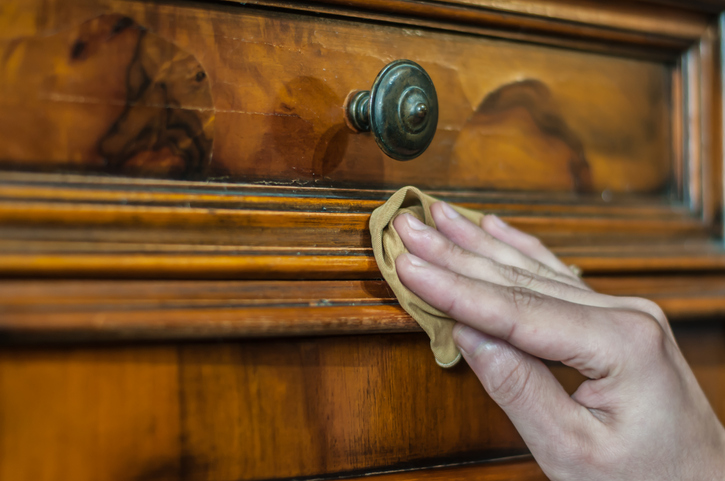Got some wooden furniture that needs a temporary home?
You might be thinking it’s just a matter of putting it in a storage unit and forgetting about it until you need it again. If only it was that simple.
Wood furniture is particularly finicky when it comes to changes in temperature and humidity, which can lead to cracking, warping and splitting. Bummer, right? But don’t throw in the towel just yet. From modern to antique pieces, we’ve got the lowdown on how to prep your furniture for storage and the best tips for stashing your wood furniture in a self-storage unit.
- How To Prepare Furniture for Storage
- Moving Furniture for Storage
- How to Store Wood Furniture
- Where to Store Wood Furniture
How To Prepare Furniture for Storage
So, you’ve made the smart decision to store your furniture — that’s halfway there! Now, there’s a bit of groundwork before everything can be stowed away in the storage unit. It is key to prep your furniture the right way to make sure it stays as good as new until you need it again. And let’s be honest, no one wants to unwrap their furniture and find it damaged or, worse, crawling with bugs.
1. Clean Furniture for Storage
Before you even think about wrapping up your belongings, Wendy Wang, the owner of F&J Outdoor and someone who has extensive experience with storing wood and upholstered furniture, says to give it a good cleaning.
“For both wood and upholstered furniture, we always ensure they are thoroughly cleaned and dried,” she said. This is especially important for outdoor furniture, which can collect a lot of dirt and grime during its time outside.
- Cleaning wood furniture: Use gentle wood cleaners like Murphy Oil Soap or a mix of warm water and dish soap. Use a soft cloth or sponge to lightly scrub and avoid anything too abrasive.
- Cleaning upholstered items: Use an upholstery cleaner and make sure everything is bone dry to avoid any nasty mold growth.
2. Treat/Polish Furniture for Storage
Treating and polishing your furniture does more than make it look good; it adds a protective layer against potential damage. Bob Thomas, owner of Hearth and Petals and an interior decorator with over 10 years of experience, says this is a must-do step.
“I stored both a wood dining set and an upholstered living room set for about eight months,” he said. “Before storing them, I wiped all surfaces with a furniture polish that contained UV inhibitors to protect from fading.”
Wang agrees. “We apply a protective sealant to guard against potential humidity that could cause warping and cracking,” she added.
The bottom line is, whether using commercial furniture polish, protective coatings like wax or varnish or even homemade solutions made from olive oil and vinegar, it is crucial to treat wood furniture thoroughly to prevent it from drying out and to preserve the finish.
Polishing can also come into play for upholstered furniture if it has any metal sections. These bits must be treated with a metal cleaner and a polishing cloth, which helps remove existing oxidation and can delay tarnish build-up.
3. Disassemble Furniture for Storage
Ivo Iv, founder of Decor Home Ideas and home improvement expert with 20 years of experience, says to consider taking furniture apart, a time-consuming task some often overlook. “It might sound tedious, and to be honest, it is. But disassembling and storing the parts minimizes the risk of damage.” He also reminds DIYers to label each piece carefully, using a practical method of little sticky notes, some tape and a clear marker.
Disassemble the items by breaking down desks, tables, chairs, bookshelves and the like into smaller, more manageable parts. Remove drawers from dressers, take legs or cushions off couches and remove TVs from their built-in stands. Doing this streamlines the packing process for both your truck and storage unit AND cuts down the chances of damaging your items.
Then, pop all screws, bolts, Allen wrenches and other small items into a labeled baggie for safekeeping. Stash this baggie with the relevant piece of furniture, for instance, by taping it underneath — it’s a simple step that will make a big difference when it’s time to reassemble.
Pro tip: Use your phone to snap a pic of each stage of disassembly for future reference.
4. Covering and Wrapping Furniture for Storage
To ensure your furniture stays in tip-top condition while in storage, it is vital to cover it properly. Breathable cloths, blankets, bedsheets, furniture pads or moving blankets are your best friends here — they prevent dust and moisture accumulation and shield from scratches, light and dust.
Avoid using thick plastic covers or bubble wrap for furniture as they can trap moisture and create condensation, leading to furniture damage. Also, they may not provide enough protection from scratches or bumps. Instead, drape furniture with breathable materials like old sheets, blankets or drop cloths. Make sure to loosely drape the material over the furniture so that your items can breathe and avoid moisture accumulation which can cause the furniture to swell.
Moving Furniture for Storage
Now that your furniture is prepped and ready for storage, it’s time to tackle the move. To avoid damaging your furniture while moving, you need to handle everything carefully, take precise measurements and sometimes it is best to get a little help from the pros.
- Measure your furniture. Getting the measurements of your furniture before you start moving is an important step. Knowing the dimensions ensures everything fits through doorways, into vehicles and in the storage space.
- Handle with care. Furniture can get damaged easily during the move. The challenge of moving items depends on their size, weight and the distance to be moved. If you have a lot of heavy stuff, think about getting some professional movers or maybe even renting a moving truck. If moving yourself, make sure to clear pathways and take precautions to avoid damage.
- Protect and secure your furniture. Use moving blankets to cover your furniture during the move. Also, make sure every piece is firmly strapped in place. Doing this will give your belongings that added safeguard against any nasty scratches or dents that can happen if they aren’t secured well in the moving truck.
Pro Tip: Consider the furniture material! For example, many couches and beds are made of pine, which is a lightweight softwood that you have to be especially careful when moving, as it can be easily damaged or scratched.
How To Store Wood Furniture
After all the effort you’ve put into getting your furniture ready for storage, the next challenge is making sure you store it the right way. Seriously, this isn’t a step o gloss over! Wood furniture requires some special attention to make sure it doesn’t get damaged while in storage.
Use Climate Controlled Storage
Wooden and upholstered furniture absolutely need a climate-controlled environment to prevent damage.
“Some people believe that wooden furniture’s lifespan is 10 to 15 years. From personal experience, I’m afraid I have to disagree,” Iv said. “With proper care and the right storage conditions — ideally a room with temperature control between 55-85°F — that lifespan can be significantly extended,” he added.
If you don’t opt for a climate-controlled storage unit, consider using humidifiers, dehumidifiers or humidistats to control moisture at home.
Raise Furniture
Keep things off the ground, which does two things: one, it keeps critters and rats away from your items and, two, protects your belongings in case of a flood.
“Simple wooden blocks or even bricks wrapped in cloth do the trick,” Iv said. “Especially handy if you live in an area that sees frequent rains or is flood-prone.” Simply put, make sure to place your furniture on pallets, planks or blocks to protect against flooding, moisture and other elements.
Leave Space and Avoid Stacking
No need for furniture pieces to rub shoulders, a safe distance between them helps prevent damage and moisture buildup. So, remember to avoid stacking heavy furniture and always leave space between items.
Pro Tip: Keep pesky pets at bay with termite-resistant polish.
Check on Your Items
It pays to check in on your items, especially for those that are particularly valuable or cannot be replaced. Oscar Taylor, who had to store wooden furniture inherited from his great-grandparents during a tough financial period, strongly recommends checking the storage periodically.
“We checked in on them every six months or so. This saved us a few times when items weren’t covered properly,” he said.
Fortunately, thanks to proper storage techniques, there was no damage whatsoever to his items when he removed them 12 years later, including the precious wooden table and six chairs set that was a family heirloom. “Cleaning and covering aside, this is the number one tip I would suggest to anyone storing things long-term: You need to check in periodically,” he added.
Where To Store Furniture
You have prepped your furniture and moved it carefully, you now face the final question — where on earth should you store it?
How To Store Furniture in a Self-Storage Unit
Self-storage units are a solid option for long-term storage. Thomas, for example, stored his dining and living room sets in a 10×10 climate-controlled unit for about 8 months and didn’t have any issues. All of the experts swear by heated storage facilities when it comes to preventing wood and upholstered furniture from warping, molding or getting all buggy.
Remember to place your items carefully, leave space for air circulation, raise furniture off the ground and cover it with breathable materials.
How To Store Wood Furniture in a Garage or Shed
Garages or sheds can work for short-term storage but be cautious. Garages often experience significant temperature fluctuations, which can be a nightmare for wood.
- Check for cracks. Before you even think about putting your furniture in there, make sure there are no cracks or holes where rain or creepy crawlies could get in.
- Avoid direct sunlight. Find a spot where the sun doesn’t hit directly. You don’t want your beautiful wood furniture to fade.
- Keep away from the door. The temperature can change a lot near the garage door. So, try to put your stuff as far away from it as possible.
- Watch out for chemicals. Lots of us keep chemicals and paints in the garage or shed. Those fumes can be bad news for wood furniture, so keep it well away from them.
How To Store Furniture in Attic
The attic may be suitable for smaller items or short-term storage but be mindful of extreme temperatures. Iv warns that attics can become breeding grounds for mold if not properly ventilated. Besides ensuring adequate airflow, also check the floor strength and mind the dust.
Some attics have weak flooring. Before you start moving furniture up there, make sure the floor can handle the weight. Since attics can be dusty places, clean the space thoroughly and cover your furniture with sheets or covers to protect them from dust accumulation.
How To Store Furniture in Basements
Basements are a yes and no situation. If you have a finished basement with climate control, you are in the clear. But, if it’s unfinished with that notorious damp basement feel, it’s a no-go. And remember, always put your furniture on pallets to avoid water damage.
When in doubt, better to play it safe and choose another spot, like a climate-controlled storage unit, the option all of our experts agreed on as the top choice.
Master the Art of Furniture Storage
So, we have learned a lot about storing wood and upholstered furniture, haven’t we? From the initial cleaning and treating, disassembling, wrapping, moving and then the actual storing — it’s quite a journey. Whether you opt for a climate-controlled storage unit or use your garage, each step is important. Remember to raise your furniture off the ground, avoid stacking and ensure good air circulation.



